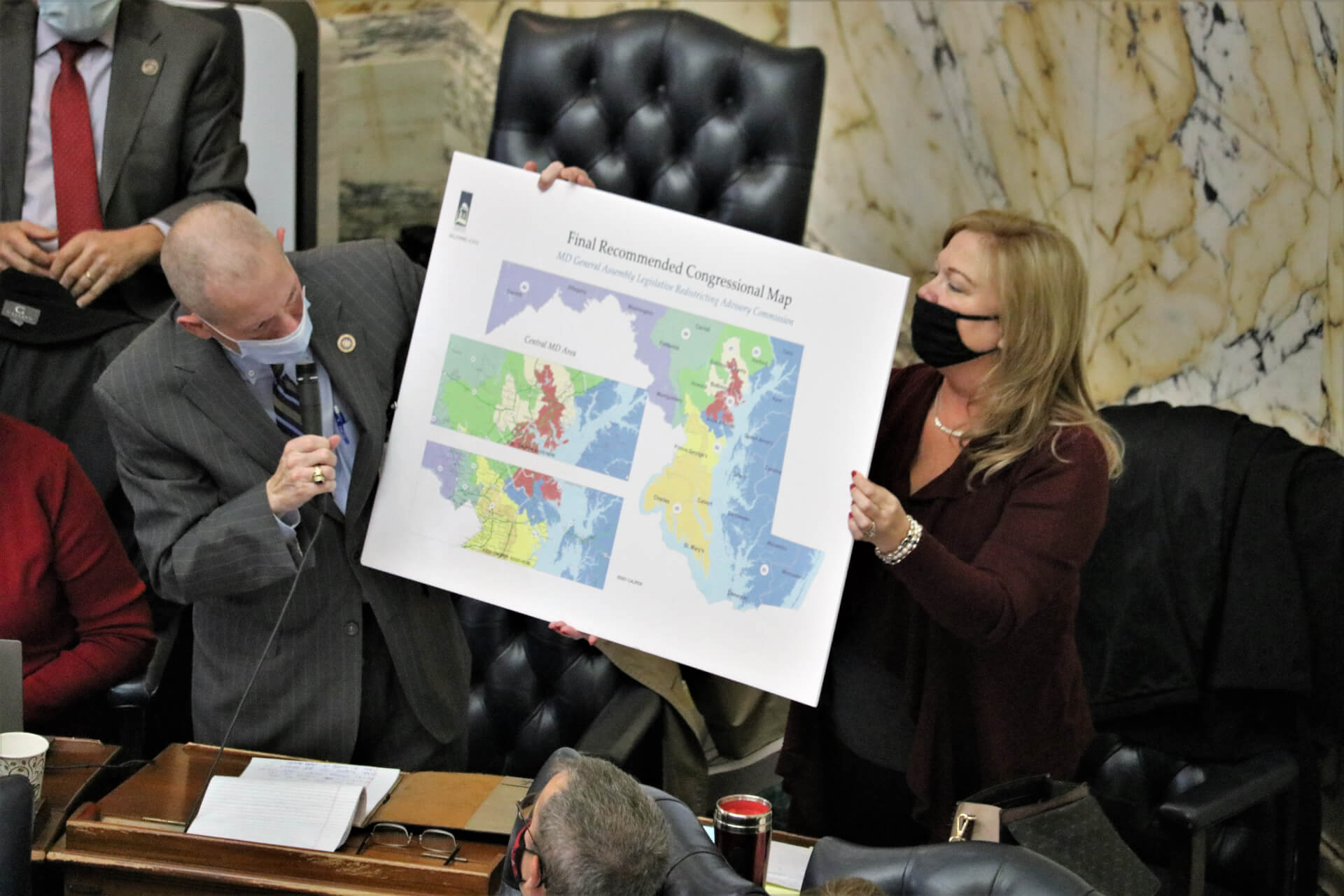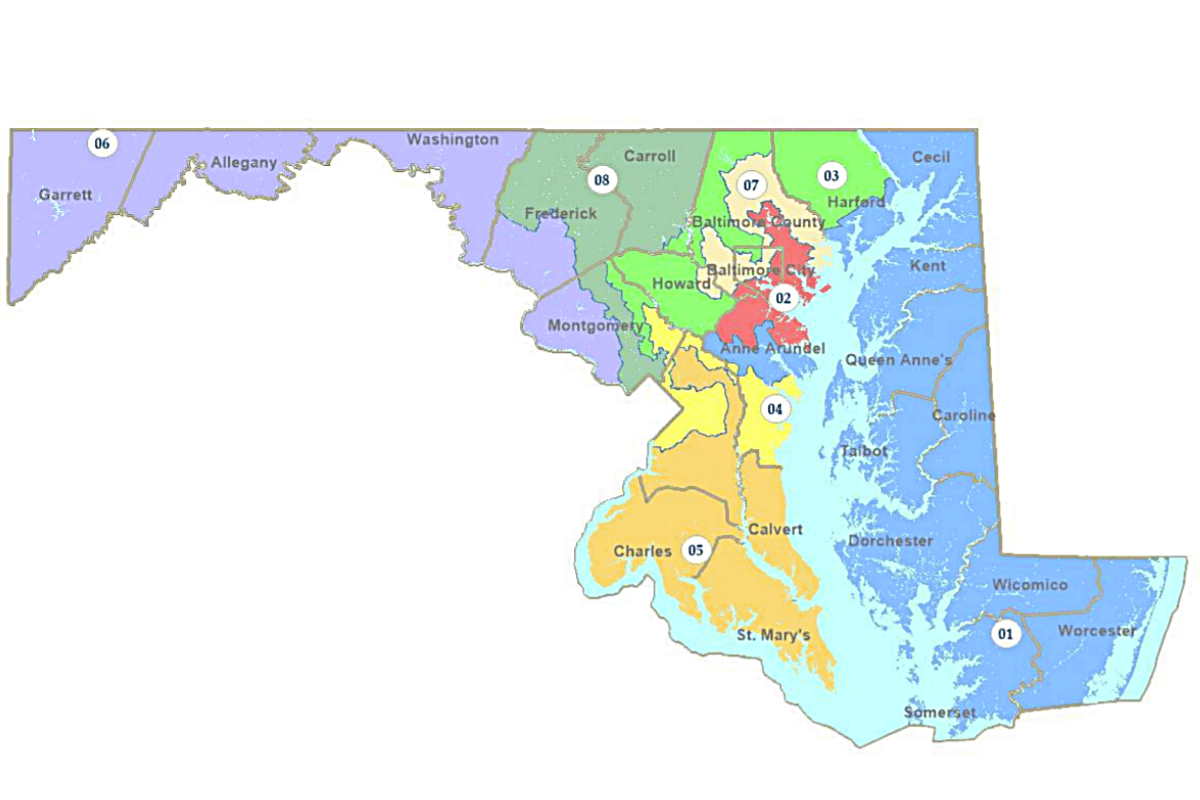House Democrats Advance Congressional District Map Opposed by Hogan, Republicans

Maryland’s House of Delegates advanced a congressional district map drafted by a legislative advisory panel on Tuesday evening, over objections from Gov. Lawrence J. Hogan Jr. and the Republican caucus.
The 97-42 vote came after nearly an hour of floor debate and just hours after Democrats in the chamber predictably rejected an amendment that would have replaced the Legislative Redistricting Advisory Commission’s map with one put forward by the Maryland Citizens Redistricting Commission established by Hogan.
The legislative panel’s proposal would create seven districts likely to favor Democrats and would move the solidly Republican 1st District into tossup territory.

The congressional map adopted by the Legislative Redistricting Advisory Commission. Screenshot from the Maryland General Assembly website.
House Minority Leader Jason C. Buckel (R-Washington) introduced the amendment that would have switched the Legislative Redistricting Advisory Commission’s proposed congressional map in House Bill 1 with the map proposed by the multi-partisan panel Hogan created.
“It’s really very compact, and it’s really very contiguous, and it represents communities of interest,” Buckel said of the Maryland Citizens Redistricting Commission map.
Buckel, one of two Republicans on the seven-member Legislative Redistricting Advisory Commission (LRAC), said he opposes the maps that commission created because the districts aren’t compact.
Buckel’s amendment was ultimately voted down, largely along partisan lines, 93-43.
In a joint committee hearing Monday, lawmakers advanced the LRAC proposal and didn’t vote on the Maryland Citizens Redistricting Commission proposal.
The LRAC was created by Senate President Bill Ferguson (D-Baltimore City) and House Speaker Adrienne A. Jones (D-Baltimore County). Jones and Ferguson are both members of that panel alongside two other Democratic legislative leaders, the two Republican legislative leaders and Karl Aro, the commission chair and former head of the nonpartisan Department of Legislative Services.
Compactness of U.S. House districts has been a key aspect of the debate on the state’s next set of congressional maps. Republicans have highlighted the fact that the Maryland Citizens Redistricting Commission sought to minimize county splits in drawing their congressional proposal, but at the Monday committee hearing on both map proposals, Aro said compactness isn’t as important a factor in congressional maps compared to population equality and compliance with the federal Voting Rights Act.
Del. C.T. Wilson (D-Charles) defended the Legislative Redistricting Advisory Commission map during the Tuesday morning floor debate on Buckel’s amendment, and said panelists focused on preserving communities of interest, protecting the voting power of people of color and keeping as many people as possible in their current districts over compactness. Wilson added that the LRAC map still marks a “dramatic change” because it is more compact than current maps, but also said Maryland’s borders don’t lend themselves to neatly drawn districts.
“The shape of Maryland isn’t pleasing to the eye,” Wilson said. “It’s misshapen and out of proportion.”
House Majority Leader Eric G. Luedtke (D-Montgomery) urged lawmakers to reject Buckel’s amendment, and said that if Hogan and Republicans in the General Assembly oppose gerrymandering they should support the federal For The People Act, which would require nonpartisan redistricting commissions across the country. That legislation, sponsored by Maryland Rep. John P. Sarbanes (D), passed the U.S. House of Representatives earlier this year but has been blocked by Republicans in the Senate.
Luedtke noted that Hogan recently took credit for the bipartisan infrastructure bill that recently passed Congress and was signed into law by President Biden, and sarcastically wondered why Hogan wouldn’t do the same for the Sarbanes bill if he was so concerned about gerrymandering.
“If he’s that influential in the [U.S.] Senate, I would urge him to call for the passage of the For the People Act,” Luedtke said.
Other House Republicans took issue with the partisan breakdown of the proposed LRAC map and the state’s current congressional districts. Current maps create a 7-1 partisan breakdown favoring Democrats, and with the 1st Congressional District redrawn to be much more competitive, the LRAC’s proposal could result in an 8-0 partisan breakdown.
“There’s definitely more Democrats than Republicans in the state of Maryland, but it’s not 7-1,” said Del. Matthew Morgan (R-St. Mary’s). He noted that after the 1990 Census, Maryland had a 4-4 partisan split in its congressional delegation, which moved to 6-2 in favor of Democrats following the 2000 Census.
House Republicans renewed their criticism of the LRAC map at the Tuesday evening floor session: Del. Haven N. Shoemaker Jr. (R-Carroll) was particularly critical of the 1st District, which in the proposed map crosses the Bay Bridge to include parts of Anne Arundel County with the Eastern Shore, and the 8th District, which as in current maps runs from the state’s border with D.C. to the border with Pennsylvania, although it would include more of Carroll County in the LRAC proposal.
“Just because something is legal doesn’t necessarily make it right,” Shoemaker said.
Susan W. Krebs (R-Carroll County) pushed back on the idea that county boundaries aren’t important in congressional maps.
“We have county delegations,” Krebs said. “We have county school boards. We do everything by counties in Maryland.”
Luedtke said Tuesday evening it isn’t that counties don’t matter — but that there are a slew of different considerations that need to be considered in redistricting, including keeping voters in current congressional districts to the extent possible and complying with the Voting Rights Act.
“There should not be any single factor that governs everything we do on these maps,” Luedtke said.
Del. Jheanelle K. Wilkins (D-Montgomery) noted that recent U.S. Census data showed that Maryland is among the most diverse states in the country, and said the LRAC proposal reflects that growing diversity.
“When I look at this map, something that I believe is absolutely critical is that we have a map that represents that diversity … and what I see here is a map that increases our diversity in several really critical congressional districts,” Wilkins said, adding that the proposed congressional map is more compact than the current one.
She noted that the number of Black residents increases in Districts 4, 5 and 7 in the LRAC map. Districts 4 and 7 would be majority Black in the LRAC proposal, and District 5 would include a Black plurality.
The Maryland Citizens Redistricting Commission map minimizes county splits and received an “A” from the Princeton Gerrymandering Project, which evaluated the proposal based on geographical features, competitiveness and partisan fairness. The Legislative Redistricting Advisory Commission’s final proposed congressional map received an “F” based on those same criteria from analysts at Princeton. Luedtke on Tuesday morning questioned Princeton’s rating system during the floor debate because it doesn’t include Voting Rights Act compliance.
The LRAC proposal is now set to be taken up by the decennial Senate Standing Committee on Reapportionment and Redistricting on Wednesday morning before heading to the Senate floor.
Editor’s Note: This story was updated after the House of Delegates evening session on Tuesday.




 Creative Commons Attribution
Creative Commons Attribution